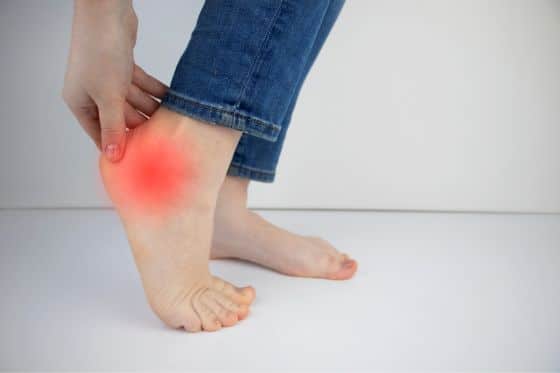As podiatrists, we see a surge of patients around this time of year struggling with heel pain. Autumn brings cooler weather, beautiful walks through crisp leaves, and the temptation to get outside for hikes, runs, and family activities. But the change in seasons also means a change in footwear, surfaces, and routines, all of which can contribute to discomfort in your feet—especially your heels. In this blog, we’ll explain why heel pain is so common in autumn, what causes it, how to manage it, and what you can do to enjoy the season pain-free.
Why Heel Pain Often Appears in Autumn
Seasonal Footwear Changes
Many people swap sandals or light trainers for heavier boots in autumn. While boots can be supportive, they can also alter your gait and place different stresses on the heel. If the footwear doesn’t fit properly or lacks cushioning, heel pain can develop quickly.
Increase in Walking and Outdoor Activities
Cooler temperatures make autumn an ideal season for walking, hiking, or playing sports. While these activities are excellent for fitness, they often mean an increase in mileage or time on your feet. Without proper conditioning or supportive footwear, heel pain is a common outcome.
Harder Ground Surfaces
In autumn, paths and pavements become harder underfoot as the weather cools and ground softens less. This change in surface density can add extra impact with every step, straining the structures around the heel.
Common Causes of Heel Pain in Autumn
Plantar Fasciitis
Plantar fasciitis is one of the most frequent causes of heel pain we see in our clinic. The plantar fascia is a thick band of tissue running along the sole of your foot, supporting your arch. When it becomes irritated, often through overuse or poor footwear, sharp heel pain—especially first thing in the morning—is the result.
Achilles Tendinopathy
The Achilles tendon attaches to the back of the heel and can become inflamed from overuse, especially during activities like running or hill walking. With autumn sports and hikes on uneven terrain, Achilles-related heel pain is a frequent complaint.
Heel Spurs
Heel spurs are small bony growths that can develop over time due to repetitive strain. They don’t always cause symptoms, but in some cases, they can trigger or worsen heel pain, particularly during long autumn walks.
Bruising or Fat Pad Syndrome
Walking on harder ground or switching to less cushioned footwear can bruise the fat pad under your heel. This type of heel pain is often described as a dull ache or soreness that worsens after standing or walking for long periods.
Tips to Manage Heel Pain During Autumn Activities
Choose the Right Footwear
Selecting shoes or boots with proper arch support and cushioning is essential for avoiding heel pain. Look for footwear with a slightly raised heel, firm midsole support, and a cushioned insole. Avoid worn-out shoes that have lost their structure.
Warm Up Before Activities
Cold weather can make muscles and tendons stiffer. Always warm up with gentle stretches before going on a walk or playing sport. Simple calf stretches and rolling a tennis ball under your foot can help reduce the risk of heel pain.
Adjust Your Activity Gradually
If you’ve been less active over the summer, ease back into walking or running rather than suddenly ramping up. Gradual increases in activity allow your body—and especially your heels—to adapt without becoming irritated.
Stretching and Strengthening
Regular calf stretches, toe raises, and strengthening exercises for the foot and ankle muscles can relieve and prevent heel pain. Building resilience in these structures makes you less likely to suffer when activity levels rise.
Ice and Recovery
If you notice soreness after activity, applying ice to the heel for 10–15 minutes can reduce inflammation. Combine this with adequate rest days to let your tissues recover and reduce persistent heel pain.
Preventing Heel Pain as the Season Progresses
Replace Worn Insoles
Even good-quality shoes lose cushioning over time. Replace insoles regularly to ensure proper support and shock absorption, reducing your risk of heel pain.
Mind Your Surfaces
Mix up your walking routes to include softer ground, like park trails, rather than sticking only to pavements. This reduces repetitive stress on your heels.
Stay Hydrated and Mobile
Cold weather can lead to stiffness. Drinking water and maintaining mobility with daily stretches keep muscles supple and joints moving freely, helping to ward off heel pain.
When to See a Podiatrist About Heel Pain
While many cases of heel pain improve with self-care, it’s important to know when to seek professional advice. Book an appointment if:
- Your heel pain persists beyond two weeks despite rest and home care
- Pain is severe and affecting your daily activities
- You notice swelling, redness, or warmth around the heel
- You cannot bear weight comfortably on the affected foot
Podiatrists can provide a thorough assessment, diagnose the exact cause of your heel pain, and create a tailored treatment plan. This might include custom orthotics, taping, shockwave therapy, or a rehabilitation programme to restore strength and mobility.
Enjoy Autumn Without Heel Pain
Autumn is a season to be enjoyed—whether that’s walking through crunchy leaves, playing football with friends, or taking weekend hikes. Don’t let heel pain stop you from staying active. With the right footwear, preparation, and care, you can keep moving comfortably and make the most of this beautiful time of year.
Book Your Free Telephone Consultation
If you’re struggling with persistent heel pain, don’t wait for it to get worse. At Foot Focus Podiatry, we’re here to help you identify the cause, ease the discomfort, and get you back to enjoying your activities.
Call (01) 556 3662 or click here to book your free telephone consultation today and take the first step towards pain-free autumn adventures.
More Free Resources:
Read our blog – Nerve Pain Explained: Simple Ways to Find Relief and Support Your Foot Health – Foot Focus Podiatry
Check out our reviews – Google Reviews
Book an appointment – Foot Focus – Book appointment

